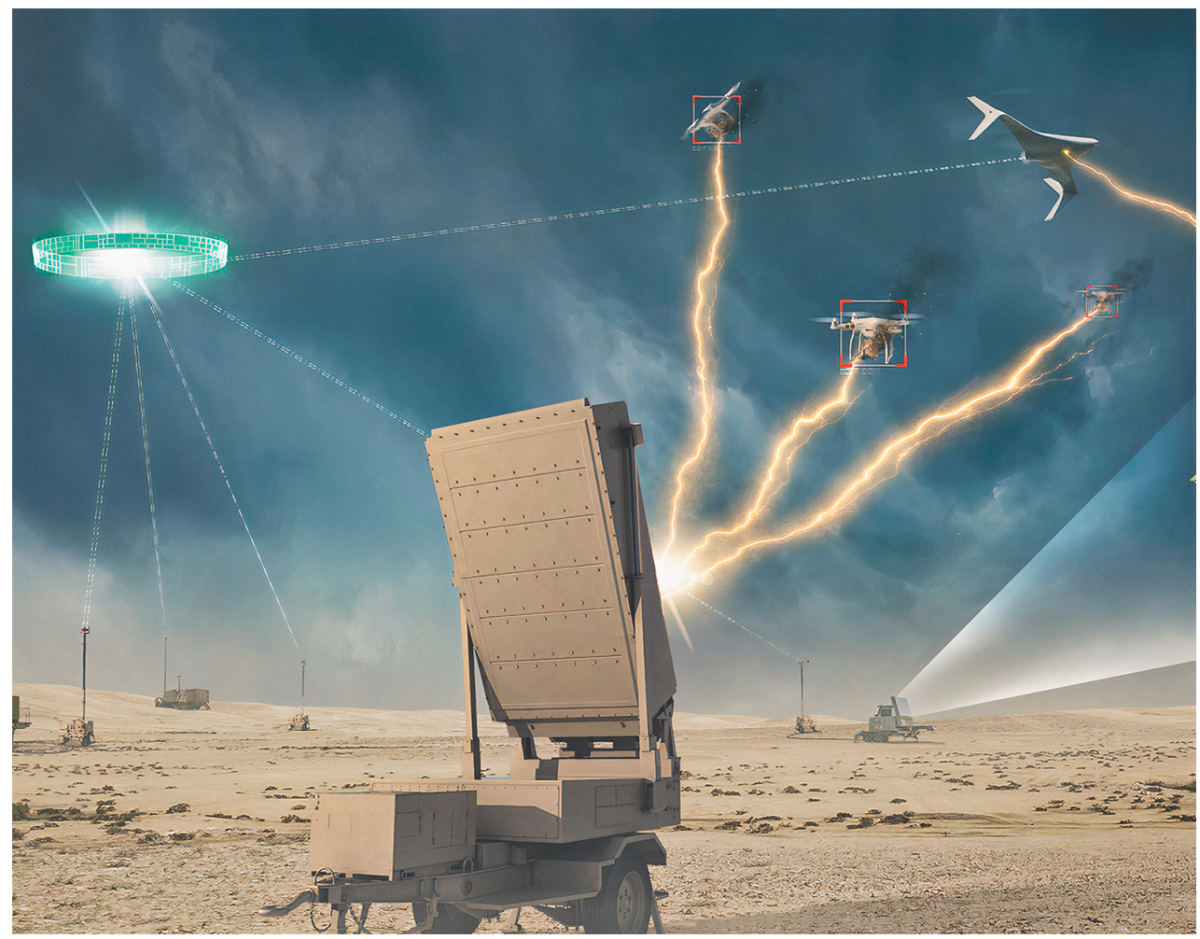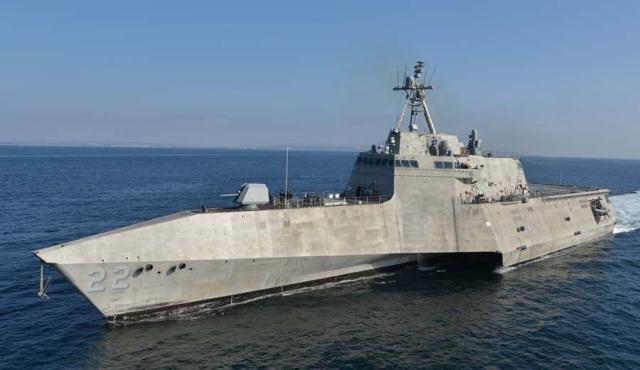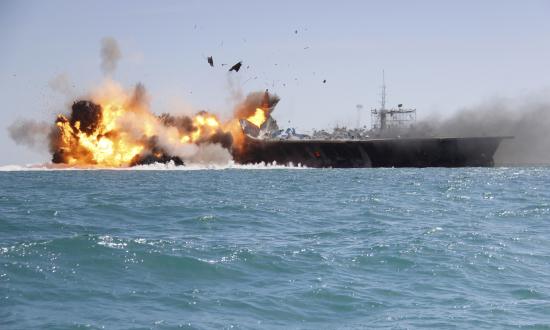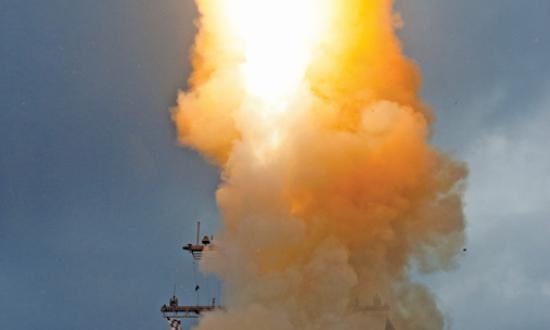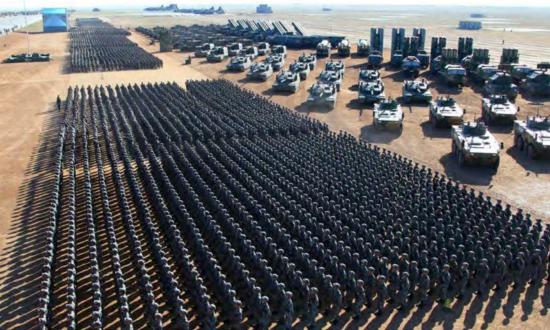The USS Nimitz (CVN-68) is steaming under a heavy overcast 700 miles east of Japan in company with the USS Jack H. Lucas (DDG-125) and USS Kansas City (LCS-22). Tensions are high in the Western Pacific. China has moved missile and amphibious forces to the western shore of the Taiwan Strait, labeling the move as a short-notice exercise. The rest of the world interprets these deployments as a show of force in an escalating campaign of intimidation to coerce Taiwan to capitulate to its demands.
At 0400 hours, the Jack H. Lucas receives a flash datalink indication that U.S. satellites have detected eight missile launches from the Chinese mainland. The directional fans for the missiles resolve to an ellipse that includes the Nimitz’s position, suggesting that DF-21D antiship ballistic missiles have been preemptively launched by China toward the carrier. The Lucas’s SPY-6 radar detects the ballistic tracks of eight inbound threats. Sounding general quarters, the ship’s captain designates the tracks as hostile, passes the tracks via datalink to both the Nimitz and Kansas City, and orders their engagement.
The Kansas City activates one of her two high-powered microwave (HPM) defense systems, each fitted inside a small modular container and mounted aft on her flight deck. The systems’ energy storage banks are already charged from ship’s power. Once the inbound targets are in range, the system’s antenna slews in their direction. With all eight DF-21 reentry vehicles inside the HPM beamwidth, a single, short- duration, extremely high-power electromagnetic pulse is fired in their direction. Seconds later, the Lucas’s SPY-6 track shows six of the eight inbound missiles are in out-of-control flight. As the HPM system quickly recharges for a second burst, the destroyer launches several SM-6 missiles to engage the remaining two reentry vehicles.
ships, such as the USS Kansas City (LCS-22) shown here. (U.S. Navy photo.)
Simultaneously, both Lucas and Nimitz detect four sea-skimming cruise missiles breaking the horizon from two different directions, headed directly for the carrier. Their time-on-target was synchronized with the arrival time of the DF-21s. Because the missiles are weaving at supersonic speed, the carrier’s close-in weapons system (CIWS) is unable to engage. And because the inbound missiles are employing sophisticated electronic jamming and have a low radar cross section, the Nimitz’s Rolling Airframe Missiles have a low probability of kill. Moreover, the inbound missiles’ different azimuths complicate defense of the carrier. However, the Kansas City quickly slews her HPM antennas to the azimuths of the inbound missiles and fires a high-energy pulse in each direction. All four cruise missiles fall harmlessly into the water.
Having survived the closely coordinated Chinese attack, all three ships continue their operations. Because the HPM system on board Kansas City reduced the need for defensive missiles on board the Lucas, more magazine space is available for offensive weapons to respond to emerging Chinese aggression against Taiwan. At the same time, defense of facilities in Taiwan, Guam, and other locations is augmented by the same HPM system, emplaced ashore.
Lagging the Threat
Every few months, the Congressional Research Service issues a “Report on Navy Laser, Railgun and Gun-Launched Guided Projectiles.” The report states that these three types of weapons being developed by the U.S. Navy “could substantially improve the ability of Navy surface ships to defend themselves against surface craft, unmanned aerial vehicles, and eventually anti-ship cruise missiles.” However, all three weapon systems suffer from one disadvantage or another.
Lasers have not yet achieved the power levels required to handle significant threats at long range (and thus only work at short range). They also have the significant disadvantage of being unable to penetrate clouds which, as any mariner knows, are a common occurrence at sea. And lasers require significant dwell time on a target to achieve a kill and can only engage one target at a time.
Meanwhile, projectiles, whether launched from a rail gun or powder gun, do not travel at light speed and must hit or pass very close to their targets to kill them, which limits their ability to counter maneuvering threats. They also require magazine space and have firing rate limitations.
Moreover, none of these weapons are particularly effective against maneuvering ballistic missile threats.
But what if there were a weapon system that operated at the speed of light, at significant range, produced near-instantaneous effects on a target, required no magazine space, had effects at altitudes where missiles cannot maneuver aerodynamically, had a beam width that could engage closely aligned targets simultaneously, and was hardly affected by adverse weather? As the above scenario describes, HPMs have these potential attributes.
Unfortunately, while the U.S. military continues to focus on developing lasers, railguns, and projectiles, its major competitor, China, is pursuing high-powered microwave technology with gusto, and is rewarding leading researchers in this area. According to The Diplomat, “Huang Wenhua, deputy director of the Northwest Institute of Nuclear Technology, received a first-prize National Science and Technology Progress Award . . . evidently awarded for his development of a HPM weapon.” Huang is not alone. Liu Guozhi, the director of the new Central Military Commission Science and Technology Commission, was also awarded for his research on HPM weapons.
China apparently views these weapons as more than just a science-and-technology dream:
“Based on [Huang’s] writings, this HPM weapon could be intended for initial employment as a ship-borne anti-missile system. For instance, in 2009, ahead of its initial test, Huang co-authored a paper focused on the utility of HPM weapons against anti-ship missiles. The authors noted that HPM weapons could be used to degrade and damage the electronics of an incoming missile, interfering with, for instance, its data link, GPS receivers, and other guidance mechanisms.”
The U.S. military will need greater defensive capability against potential Chinese aggression. Meanwhile, it is becoming more technically difficult, more magazine-space dependent, and more expensive (at a time of renewed budget constraints) to defend kinetically against Chinese and Russian ballistic and cruise missiles. Thus, an immediate goal for the Pentagon must be to find an inexpensive way to flip the advantage back to the defense. HPMs should be a focus of that work.
How do HPM systems work?
High-powered microwave weapons send a short, concentrated burst of electromagnetic radiation toward a target that is using electronics for navigation, guidance, control, or fusing. They disrupt these electronics by overwhelming them with electromagnetic energy, causing arcing and other catastrophic damage to render the device inoperable. Think of putting a fork in a microwave and the sparking that results.
There are two pathways to disrupt an incoming weapon. The first attacks a target’s front-end aperture. This path requires the least amount of energy but is only effective against weapons that need front-end apertures, such as electro-optical, infrared, or radar-homing receivers. The second pathway targets a weapon’s back-end internal electronics, including GPS receivers, inertial navigation systems, control-surface actuators, and fusing systems. This pathway requires more energy, which implies a more powerful HPM transmitter, closer engagement range, or a combination of the two. An opponent can attempt to shield a weapon from microwave energy, but this negatively impacts the performance of a front-end aperture and adds weight and complexity to back-end electronics.
Like any weapon system, an HPM system requires a detection-and-tracking system, which can also be used for battle-damage assessment. There are essentially three different technical approaches to generating microwave energy, which lead to different power levels and different tactical applications.
The lowest HPM power level is generated using fairly conventional transmitters that can be mounted on fixed or mobile platforms, or miniaturized, modular systems inserted as payloads on other systems such as unmanned aerial vehicles (UAVs). These low-power systems tend to be most useful in short-range counter-UAV applications and can be operated alongside other systems (such as lasers that burn up UAVs or radio-frequency jammers that target their control links). The next higher HPM power level involves single-purpose RF transmitters. Because they are larger and more powerful, this level of system is effective at longer ranges against both front- and back-end pathways.
The highest power level is obtained using travelling-wave tube-based systems. Imagine the power of the Hoover Dam transmitted unidirectionally in a nanosecond-length burst of electromagnetic energy. These systems will typically fit inside a small container, with an external antenna mounted on top, and can easily be emplaced on nearly any ship with a flight deck. As the technology matures, there is considerable potential to shrink their footprint. While they have been tested against representative targets at surprisingly long (but currently classified) ranges, they remain trapped in a science and technology stovepipe.
All three types of HPM weapon have applicability in an evolving security environment. Perhaps the most intriguing HPM application, however, is at high power, where they have the potential for neutralizing many of the sophisticated Chinese and Russian antiaccess/area denial systems.
If HPMs are so good, why hasn’t the Pentagon built them already?
HPM systems have gained mixed traction in the U.S. military, but their acceptance has come in inverse proportion to their power. Indeed, several low-power systems designed to counter UAVs are in production. Why? Because UAVs threaten U.S. military forces regularly.
High-power HPM systems, however, have yet to move from concept to development. There is a compelling parallel with pre-COVID-19 pandemic preparations. The U.S. government knew the potential for a pandemic existed, but because there had not been one in decades, sophisticated technologies—such as messenger RNA vaccines—only received major investment after disaster struck. Similarly, because DoD is rarely attacked at the high end of threat capability, it under-invests in cutting edge defensive technology, and existing investments are evolutionary rather than revolutionary solutions. If HPM investment continues on this track, it may be deployed too late. There are several possible reasons for this:
- Lack of a visceral negative experience. Humans tend to take threats seriously only after they happen. We have never actually experienced a sophisticated antiship cruise missile attack, much less an antiship ballistic missile attack. For some reason, neither previous, less sophisticated ASCM attacks on U.S. ships nor the early 2020 Iranian ballistic missile attack against Al Assad airbase in Iraq have compelled urgent development of these systems.
- The lack of a visible launch signature could be a psychological barrier. Military personnel are used to hearing loud noises and smoke when a weapon fires; the only physical evidence of an HPM firing is a report that the weapon fired, and the target was neutralized.
- The idea of an extremely high-powered source of electromagnetic energy could raise concern over harm to adjacent systems or people. This concern is unfounded, however, because the system fires for such a short period and its sidelobes can be shielded.
- Projecting a beam of high-power energy could raise concerns over collateral damage downrange. For example, it is theoretically possible that the beam could damage a friendly aircraft operating within the HPM beam at exactly the wrong time. But, when properly integrated into the host platform, this is a manageable challenge, especially in testing. In wartime, it would be relatively simple to adjust firing timing to avoid harm to friendly platforms based on readily available data.
- At the high end, HPM systems seem to be stuck in a science-and-technology (S&T) stovepipe and are not broadly understood by those who are responsible for force design. In some cases, the S&T world has a tendency to foster incremental improvements rather than transition a promising system to keep the funding coming.
Time to get to work
There is a saying in the business world that if you don’t disrupt yourself, someone will do it for you. In the case of HPM, the U.S. military does not want to be on the disrupted end of a competition with a potential adversary.
It is time for DoD to take these potentially disruptive weapons far more seriously than is evident in current budget decisions.
- Senior Pentagon leaders, both military and civilian, should aggressively educate themselves on HPM systems and their potential efficacy. Doing so will advance the technology because subordinates pay close attention to what their bosses are studying.
- The Navy should immediately begin wargaming the various shipboard configurations (most likely LCSs and LPDs, and possibly DDG-1000s) and operational scenarios in which such weapons would be employed.
- Research and development funding should be increased, and timelines moved forward, to either prove or disprove the efficacy of HPM technology in actual operational use. Industry will quickly and aggressively respond to a demand signal that is supported with development funding. A system should be tested at sea as soon as possible.
- Key members (and staffers) in Congress should be educated on the potential for HPM technology. Requirements for periodic progress reports should be included in legislation along with other forms of directed-energy and rail-gun systems.
The Department of Defense is behind in developing high-powered microwave technology as part of its directed energy, or “electric weapons” portfolio. Like offensive mine warfare, we wait to develop this capability at our peril.



